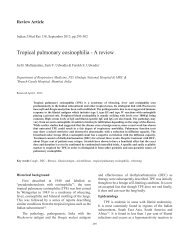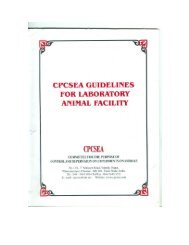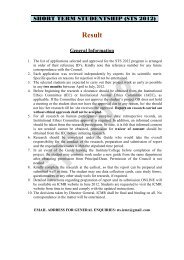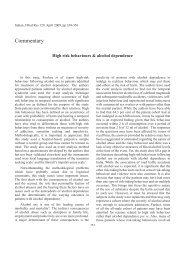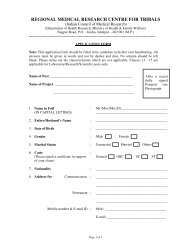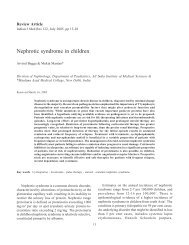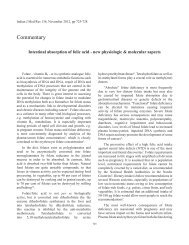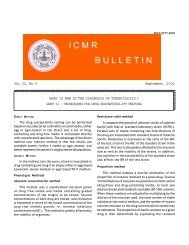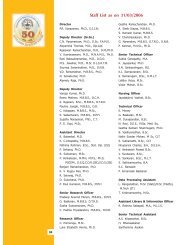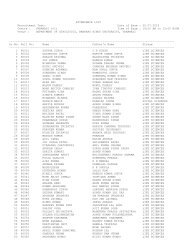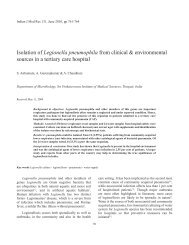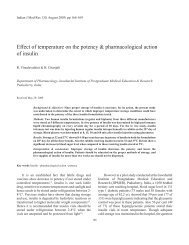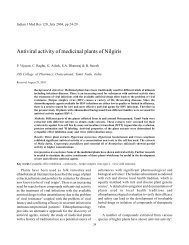(INSA) Guidelines for Care and - Indian Council of Medical Research
(INSA) Guidelines for Care and - Indian Council of Medical Research
(INSA) Guidelines for Care and - Indian Council of Medical Research
You also want an ePaper? Increase the reach of your titles
YUMPU automatically turns print PDFs into web optimized ePapers that Google loves.
Disposal : The transgenic <strong>and</strong> knock-out animals should be first euthanasised <strong>and</strong> then disposed <strong>of</strong>f<br />
as prescribed elsewhere in the guidelines. A record <strong>of</strong> disposal <strong>and</strong> the manner <strong>of</strong> disposal should be<br />
kept as a matter <strong>of</strong> routine.<br />
The transgenic <strong>and</strong> knock-out animals need greater level <strong>of</strong> monitoring than other animals as<br />
transgenes might have unexpected effect on the phenotype <strong>and</strong> its interaction with the environment.<br />
(iv) Nutrition <strong>and</strong> Feeding<br />
The results <strong>of</strong> an experiment are likely to be influenced by co-existence <strong>of</strong> nutritional deficiencies<br />
<strong>and</strong> imbalance. It is, there<strong>for</strong>e, essential that laboratory animals are maintained on a balanced diet<br />
based on nutritional requirements <strong>of</strong> each species. Special care is needed on nutritional elements,<br />
ingredients used in diet, <strong>and</strong> feeding practices. A balanced diet should contain protein,<br />
carbohydrates, fat, minerals, vitamins, roughage <strong>and</strong> water in required proportions <strong>for</strong> each species<br />
<strong>of</strong> animal. These requirements <strong>for</strong> commonly used species are given in Annexure-6.<br />
Only quality ingredients should be used in a diet <strong>and</strong> they should be free from dust, moulds, fungi<br />
<strong>and</strong> other contaminants. Each animal must get required quantity <strong>of</strong> feed, based on animal<br />
maintenance <strong>and</strong> production requirements.<br />
The feed should be palatable so that it is consumed in adequate quantity by the animals. Any<br />
undesirable odor always causes under consumption resulting in nutritional deficiency in the animals.<br />
No drug, hormone or antibiotic should be added in the feed as these are likely to disturb the normal<br />
metabolism <strong>of</strong> the animals <strong>and</strong> produce biased results.<br />
The ingredients <strong>and</strong> the prepared feed must be stored <strong>and</strong> h<strong>and</strong>led carefully so as to avoid any<br />
contamination. The food must be <strong>of</strong> right consistency <strong>and</strong> should be presented to animals in proper<br />
type <strong>of</strong> hoppers to avoid wastage. In some cases the feed may be divided in 2-3 meals during the<br />
day.<br />
Pelleted feeds balanced <strong>for</strong> different species <strong>of</strong> animals are now available commercially. These are<br />
easy to procure <strong>and</strong> use without wastage. However one has to be careful on quality <strong>of</strong> the feed from<br />
batch to batch. It should be obligatory on manufacturer to mark each bag with the type <strong>of</strong> food, date<br />
<strong>of</strong> manufacture, the batch number, the ingredients used <strong>and</strong> chemical composition. R<strong>and</strong>om<br />
chemical analysis must be carried to <strong>for</strong> major nutrients to monitor the quality <strong>of</strong> food from time to<br />
time.<br />
Clean, chlorinated water should be available to the animals ad lib.<br />
(v) Hygience <strong>and</strong> Disease Control<br />
The building <strong>for</strong> housing the animals should be provided with barriers to control the entry <strong>of</strong><br />
contamination into the building through men, material <strong>and</strong> wild animals. Strict barriers should be



